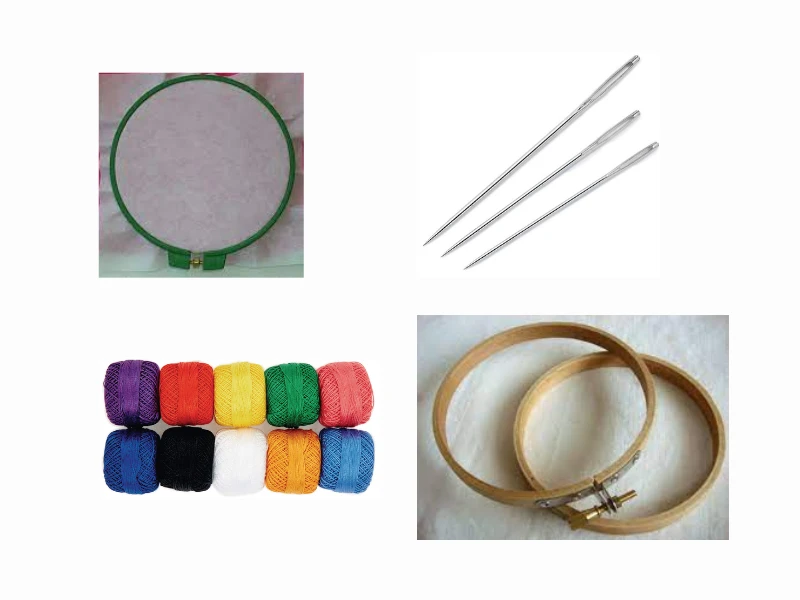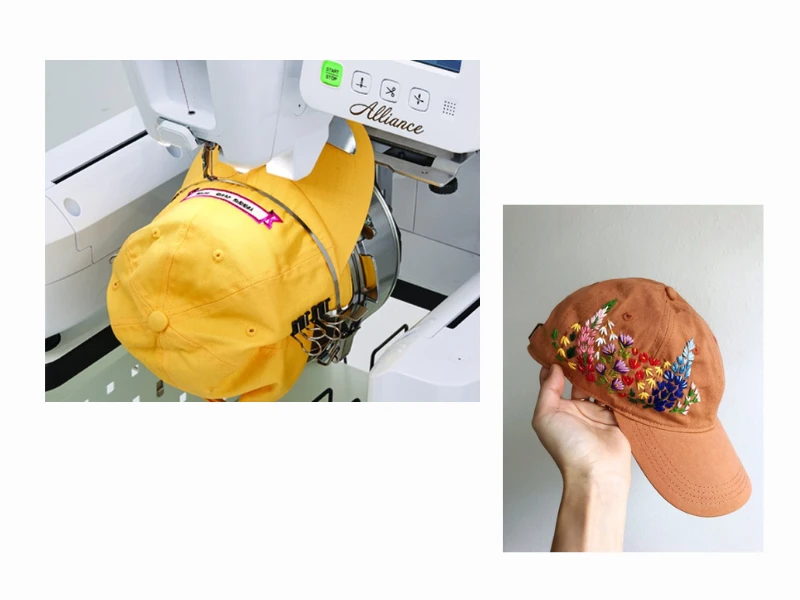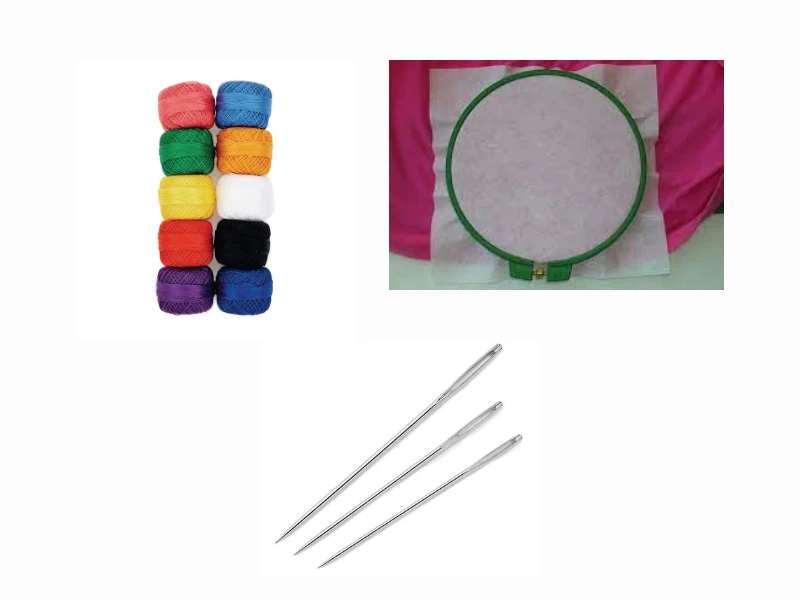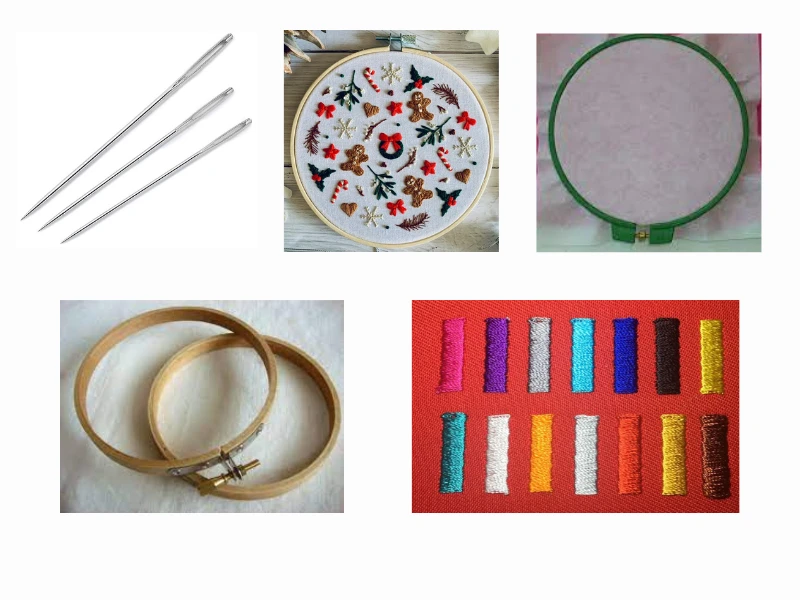
The time it takes to embroider a hat is determined by many different factors, each of which has an effect on the overall workflow.
Design Complexity: Intricate designs with detailed patterns require more stitches and, consequently, more time. A simple logo might take minutes, while a detailed monogram can take hours.
Embroidery Method: Machine embroidery is significantly faster than hand embroidery, though the latter offers a distinct handcrafted touch.
Material and Fabric: Thick fabrics, such as denim or leather, can take longer to embroider as they demand specialized needles and additional stabilizers.
Setup Time: Hooping the hat correctly, aligning the design, and preparing the machine or workspace also add to the overall time.
For example, a basic machine embroidery design might take 20 to 30 minutes, while a complex, hand-embroidered pattern can take up to 10 hours or more.

Having the right tools in your hands can make all the difference in the quality and efficiency of your embroidery. Here's what you'll need:
Embroidery needles of varying sizes for different thread types.
Hoops or frames to keep the fabric tight and prevent stretching.
High-quality embroidery threads, such as cotton or silk, depending on your project.
Stabilizers to secure the fabric, especially for structured hats.
An embroidery machine with a cap frame attachment for secure hooping.
Digitized design files formatted for your specific machine.
Polyester threads for durability and vibrancy.
Pre-cut stabilizers are designed for curved surfaces like hats.
Purchasing high-quality tools not only improves your results but also minimizes errors and reduces time.

The choice between hand and machine embroidery often depends on the project’s purpose and time constraints:
Hand embroidery adds a distinct, handcrafted touch to different designs. It's challenging and time-consuming, yet it allows for artistic expression and precise design. For instance, a flower design or personalized monogram stitched by hand can take hours to perfect but exudes exclusivity.
Machine embroidery is perfect for different projects requiring speed and consistency, such as bulk orders or intricate designs. Advanced embroidery machines can manage thousands of stitches per minute, achieving tasks that usually require hours by hand. They also enable for accurate replicating of designs, making them a popular choice among businesses.
For example, embroidering a simple logo by machine might take just 15 to 20 minutes, whereas completing the same design by hand could take several hours.

The right materials are important to achieving a perfect and professional look:
Threads: Polyester threads are the industry standard because of their longevity, vibrant colors, and fade durability. They are ideal for hats that may experience regular wear and tear.
Stabilizers: Tear-away stabilizerswork well for structured hats, while cut-away stabilizers are recommended for more flexible fabrics. These prevent fabric puckering and maintain design alignment.
Needles: Using a 75/11 or 80/12 needle ensures clean, precise stitches, even on thicker materials like denim or leather.
Selecting the appropriate materials not only enhances the embroidery's look but also ensures longevity.
The time required for hat embroidery depends on various factors, including the design's complexity and the chosen method:
Hand Embroidery: A basic design may take 2 to 4 hours, and complex designs might take 10 hours or more.
Machine Embroidery: Machines work at different speeds, which are commonly measured in stitches per minute (SPM). For example, a design with 10,000 stitches at 500 SPM would take around 20 minutes to complete, plus extra time for trimmings and color changes.
Machines that operate at 500 to 600 stitches per minute may create a 10,000-stitch design in about 20 minutes, excluding setting and finishing touches.
To enhance efficiency in your embroidery projects:
Optimize Design: Simplify intricate designs where possible to reduce stitch count.
Proper Hooping: Ensure the hat is hooped correctly to prevent movement, which might lead to problems and require rework.
Machine Settings: Adjust your machine to an optimal speed, for hats, running at about 600 stitches per minute is advisable, though this can vary based on design complexity.
Quality Materials: Using high-quality threads and stabilizers can prevent thread breaks and other issues that slow down the process.

Embroidery, especially on curved surfaces like hats, can be tricky. Avoid these common mistakes:
Incorrect Hooping: Improperly hooping the hat can lead to design misalignment or puckering. Use a cap frame or hoop specifically designed for hats.
Wrong Needle Choice: Using a needle that’s too thin or unsuitable for the fabric can cause thread breaks or skipped stitches. Always match your needle size to the material.
Poor Stabilization: Not using a stabilizer or choosing the wrong type can result in uneven stitching. Choose a stabilizer that suits the fabric's weight and texture.
Ignoring Thread Tension: Incorrect thread tension can lead to loose stitches or thread breakage. Adjust your machine's tension settings as needed.
Overloading the Design: Too many details or a dense stitch count can overwhelm the fabric, causing it to stretch or tear. Simplify designs when working on small or thin hats.
Avoiding these mistakes ensures a smooth embroidery process and a professional finish.
Embroidering a hat presents some challenges due to its curved surface and varying fabric types. However, with practice and the right tools, it becomes manageable. Starting with simple designs can build confidence before progressing to more complex patterns.
Nick William has been immersed in the world of embroidery digitizing for over 20 years, earning 25 industry awards throughout his career. As a 3rd generation embroidery expert, Nick’s journey started in his family’s workshop, where he learned the art of digitizing before the rise of modern software. He has worked with leading commercial embroidery businesses and has shared his expertise with over 75,000 home and professional embroiderers. As an author at True Digitizing, Nick is passionate about teaching others how to create beautiful, precise designs through easy-to-follow tutorials and expert advice.
Categories

How To Convert PNG to Vector File: Step-by-Step Guide
25-04-2025

11 Tips To Create High-Quality Embroidery Designs
24-04-2025

Understanding Popular Machine Embroidery File Formats
23-04-2025

Is SVG A Vector File? Here’s the Shocking Truth Everyone Should Know
17-04-2025

6 Popular Types of Vector Files 2025
16-04-2025

How To Create A Vector File: Step-by-Step Guide
15-04-2025

What Is A Vector File? Everything You Need To Know
14-04-2025

Best Janome Embroidery Machines You Need to Check Out in 2025
11-04-2025

Custom Embroidery Digitized Designs For Hoodie Lovers
10-04-2025

Best Embroidery Patches For Your Clothes
10-04-2025